Conversion tracking is one of the most critical and often overlooked tasks for any marketer, whether you work in SEO, PPC, social media marketing, or consider yourself more of a generalist.
In this article, we’ll walk you through the steps to set up conversion tracking within GA4. While the deadline for moving to GA4 has passed and UA (Universal Analytics) properties no longer collect new data, GA4 remains a black box for some marketers. That’s why we’ve put together this step-by-step guide to help you.
We’ll explain how to set up conversion tracking in GA4 and why it’s so important to track conversions alongside your SEO testing schedule.
Top Tip: If you want to go more granular with your conversion data in GA4, set up custom audiences. For information on how to do this, give our GA4 audience guide a read.
Events vs key events vs conversions
Before we teach you how to set up conversions within your GA4 dashboard, we need to clarify some terminology.
As of the 1st of March 2024, Google has renamed ‘conversions’ as ‘key events’ across the platform. You may still see conversions used in specific context reports measuring your Google Ads campaign performance. However, in all other areas of GA4, whenever ‘key events’ are mentioned, these are your ‘conversions’ within GA4.
This change is due to the fact that GA4 is an events-based model, whereas Universal Analytics was a session-based model. Now, almost any action taken on your website can be tracked as an event. These events include anything from clicks and scrolls to bouncing between pages. So, it makes sense for Google to label key events as different conversions, allowing you to set almost anything that happens on your website to be known as a conversion.
If you need to brush up on your GA4 knowledge, look at our Google Analytics 4 guide. This article includes the essentials, from setting up your account to navigating the interface and utilizing its advanced features.
How to set up conversions in GA4 (step by step)
This section will take you through how to set up your conversions within GA4, step by step.
Sign in to Google Analytics
To start, you need to sign in to your Google Analytics account. Head to https://analytics.google.com/, and you’ll be greeted with the Google sign-in screen:
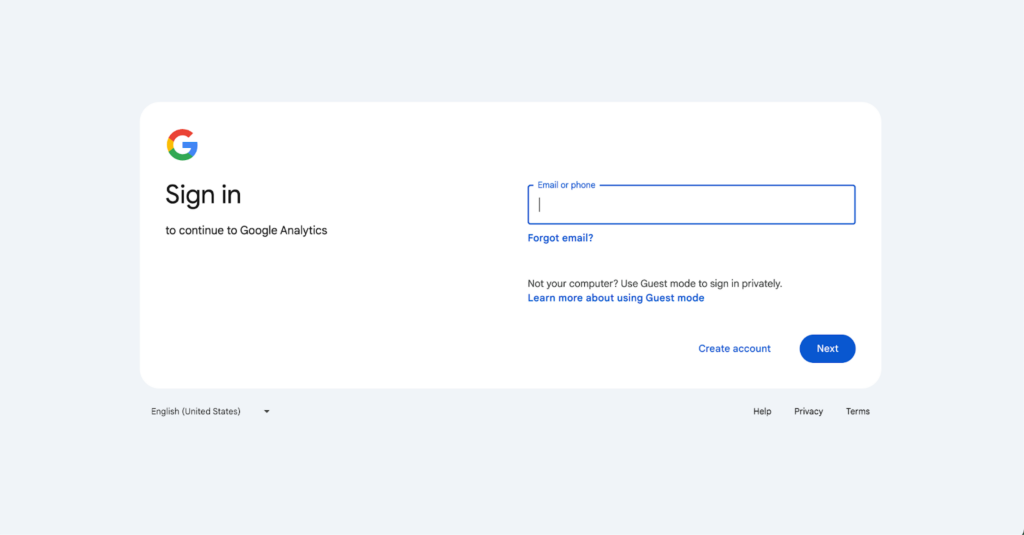
Enter your email and password, and you will be redirected to your Google Analytics dashboard.
Access your GA4 property
From here, your next step is to select the correct GA4 property. Click on the ‘accounts’ tab at the top of your screen as shown below:
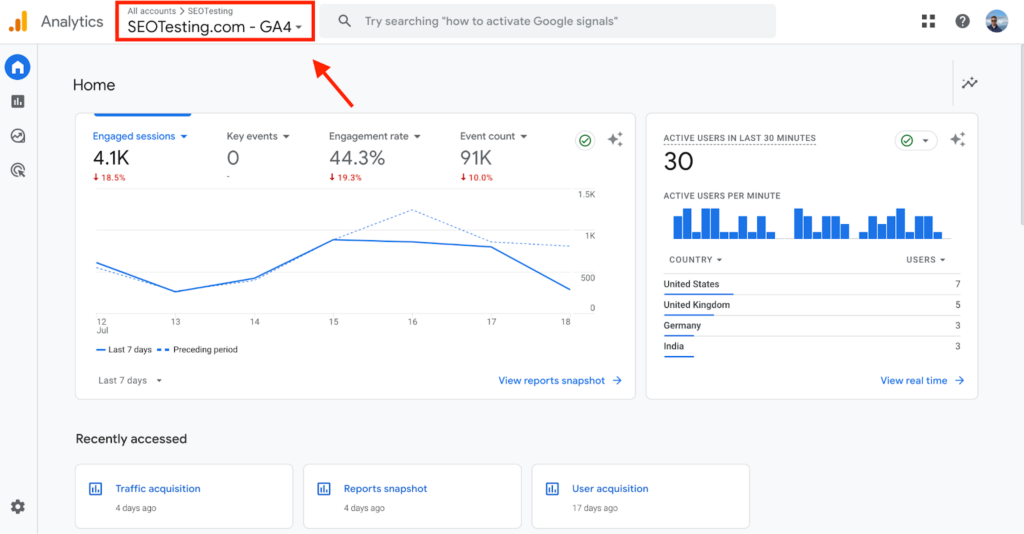
This will bring you to a dropdown showing all of your GA4 properties that you have access to within your Google account. Simply click on the one you’d like to access:
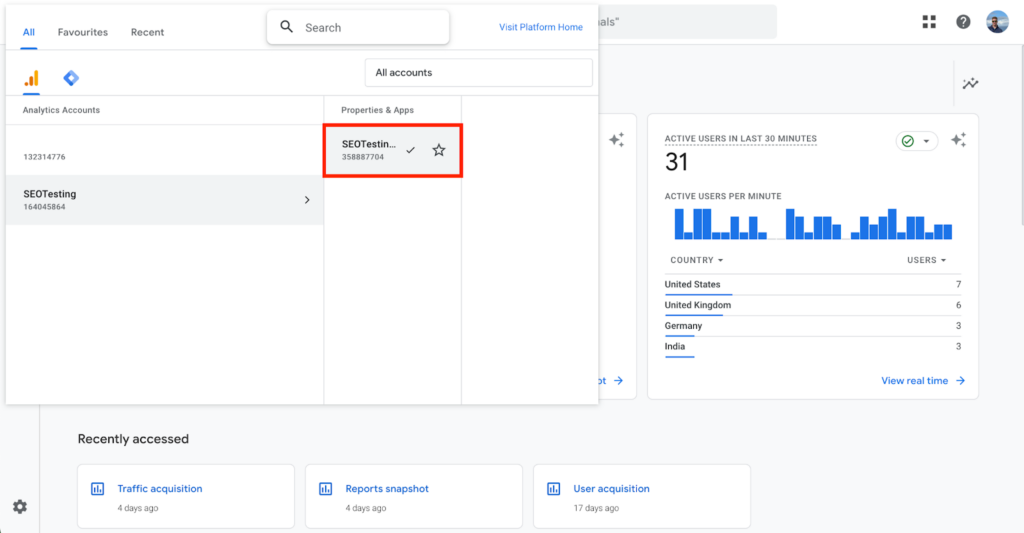
Navigate to events
Head to the’ events’ section to add conversions to your Google Analytics 4 dashboard. As we explained in our GA4 guide, GA4 is an event-based analytics system, so all key actions are now labeled as events within the platform.
Your starting point is the admin section within GA4.
Scroll over the navigation bar on the left side of your screen to extend the navigation area, and click on the ‘Admin’ label at the bottom as labeled below:
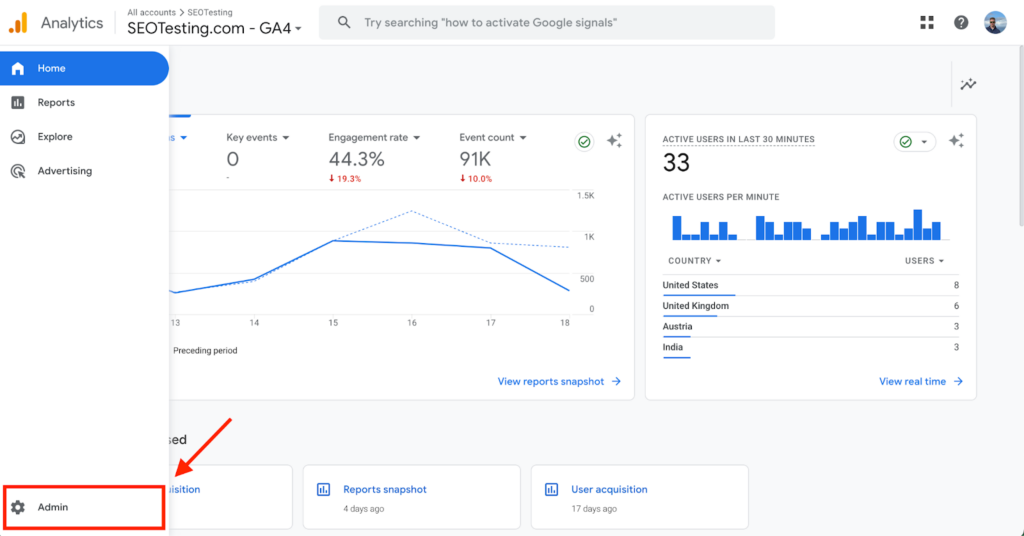
Navigate to the ‘Events’ tab in your GA4 administration dashboard. This is listed within the ‘Data display’ section of the ‘Property settings’ menu:
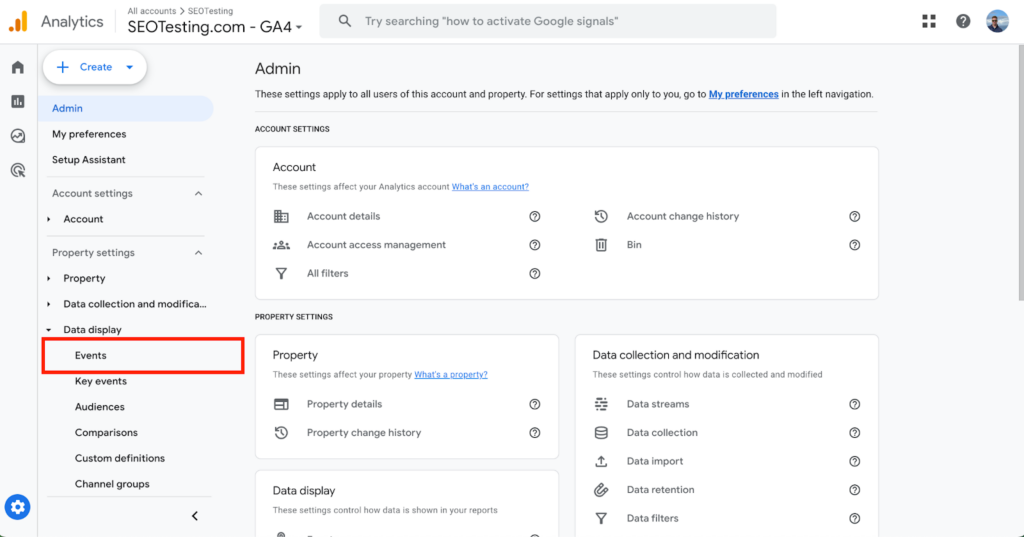
Click on ‘Events’ to bring up your event information. You may already see a list of predefined events set up previously by someone else in your organization or are there by default. This is an example of how your events section may look within GA4:
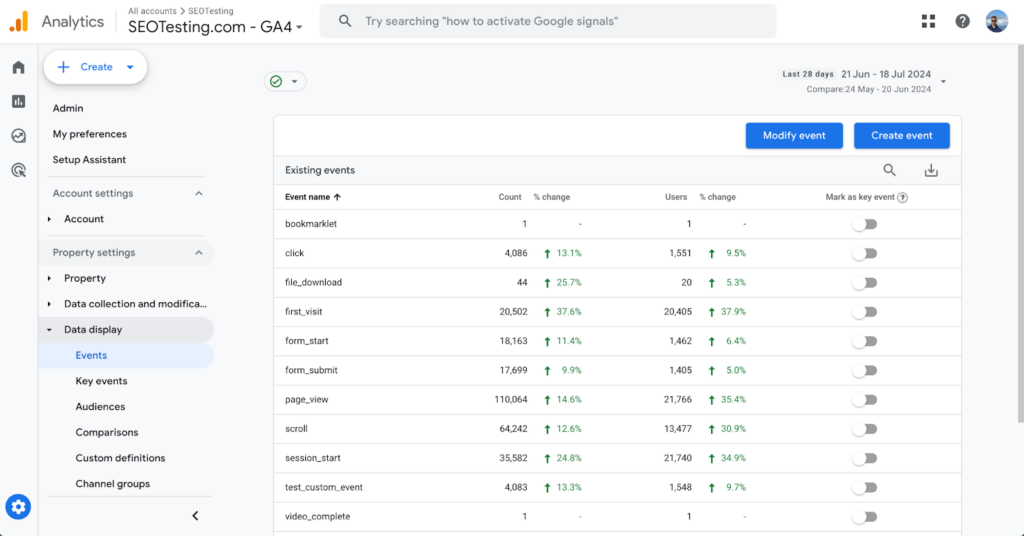
Create or identify an event
You can modify events already listed, but we will take you through creating a brand new event for this article. Click on the ‘Create event’ button to start this process.
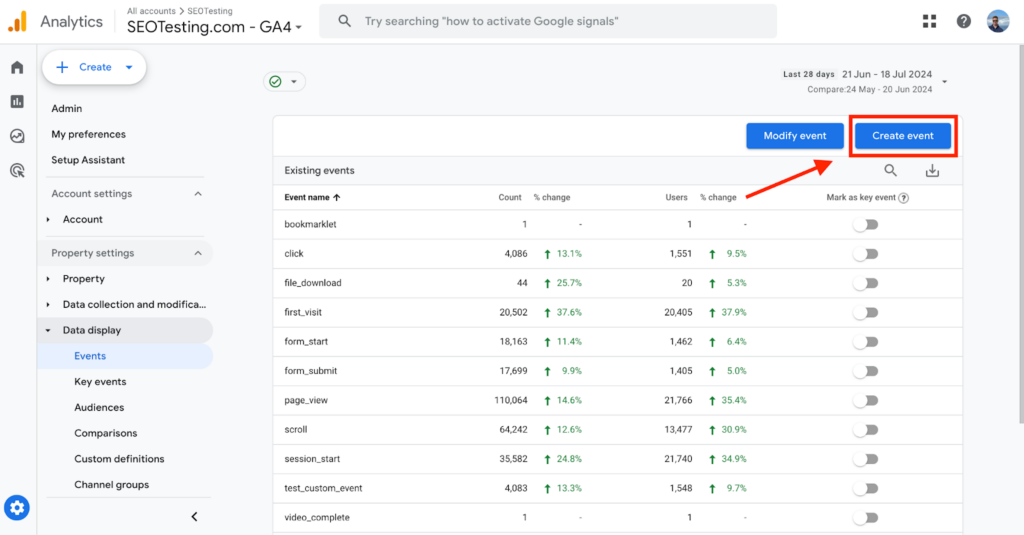
A new pop-out will appear here. You should click ‘Create’ again.

Once you click this button, a new screen will appear where you can set all the parameters for your event. For this article, we will create an event.
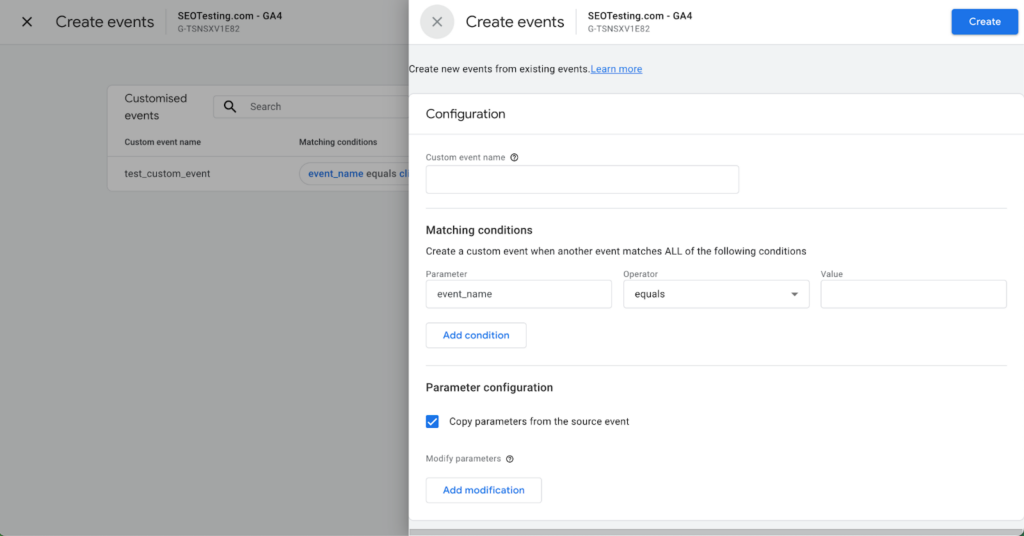
It’s here that you need to fill in your conversion information.
Let’s start with the event name.
It’s important to note that GA4 uses snake case, so all of your events should be written in lowercase letters, using underscores instead of spaces. For example, if you wanted to name your event ‘free trial started,’ you must write it as free_trial_started to keep the same naming convention.
For this article, let’s call our event: free_trial_button_clicked
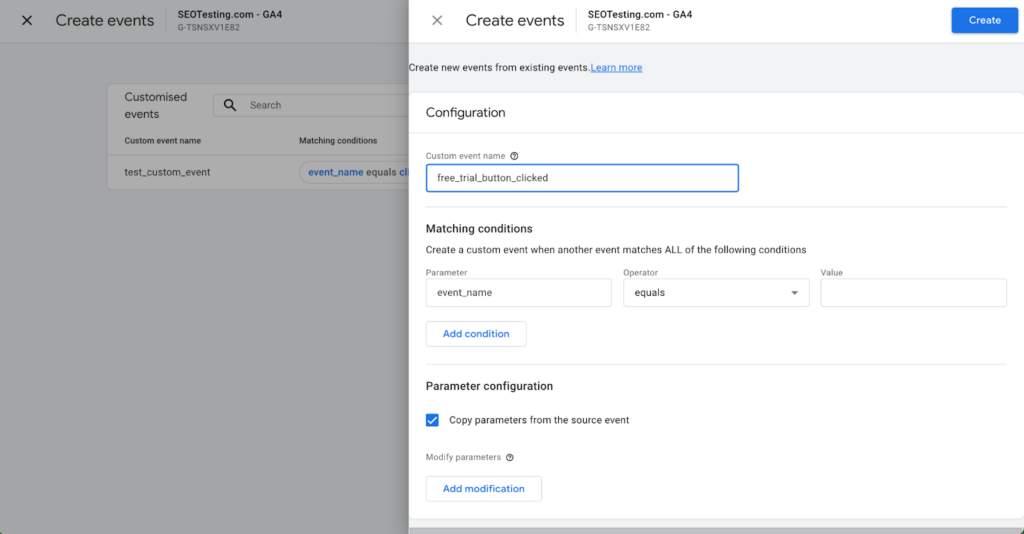
We then need to set the conditions for when this event is triggered. Using our example, when customers click the button on our website to create a free trial account, they are taken to a page ending with ‘/account/register/,’ so we need to ensure this is mentioned in GA4.
Let’s start with the parameter:

For GA4 to trigger the event, we need it to fire when a user sees a page. So, the first step is to ensure the operator is listed as ‘equals’ and the value is written as a ‘page view’ so GA4 knows to trigger the event when a page is viewed.
We then need to set the page:

As you can see below, we have listed out all the details that need to happen for this event to be triggered:
- Parameter: A certain page location
- Operator: equals
- Value: The URL of our account creation page.
Once this is done, simply click the ‘Create’ button.
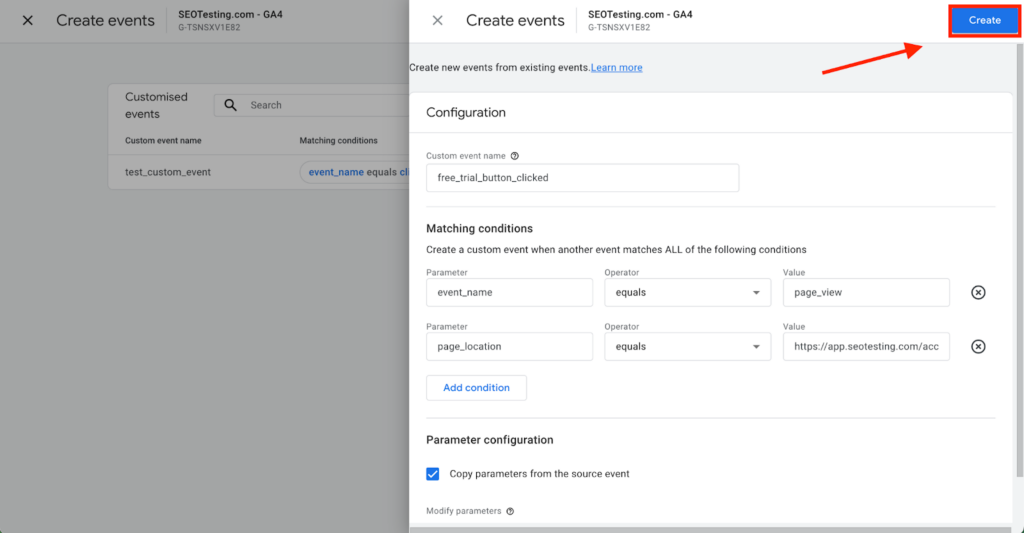
… And your new event will now be listed.
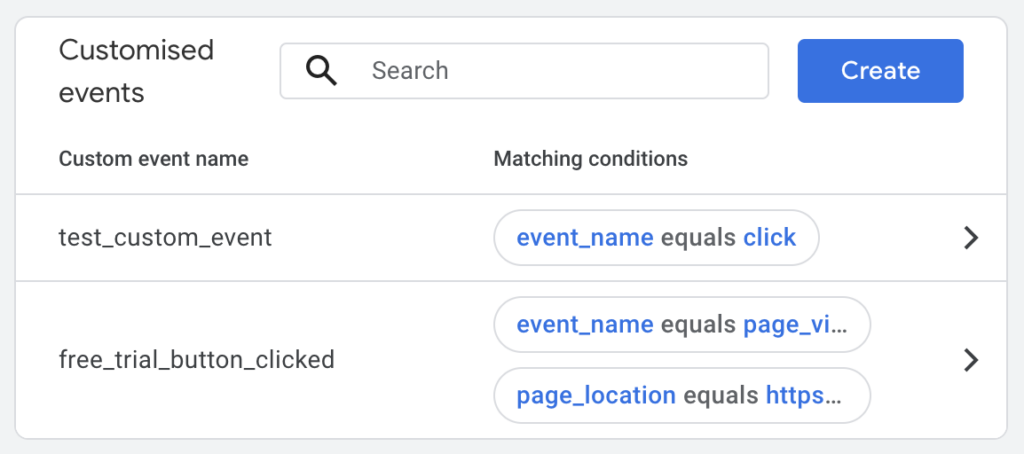
You’ll now see this event triggered in all your event reports within GA4. However, to ensure the event is marked as a conversion, we need to list it as a ‘key event’ within GA4.
Note: You must wait for the event to be triggered before it appears in your list of events.
Mark the event as a conversion
To ensure the event you created is treated as a conversion by GA4, you must check that it’s listed as a ‘key event.’ To start, head to the ‘Key events’ section in the same admin settings you were just on to create your event:
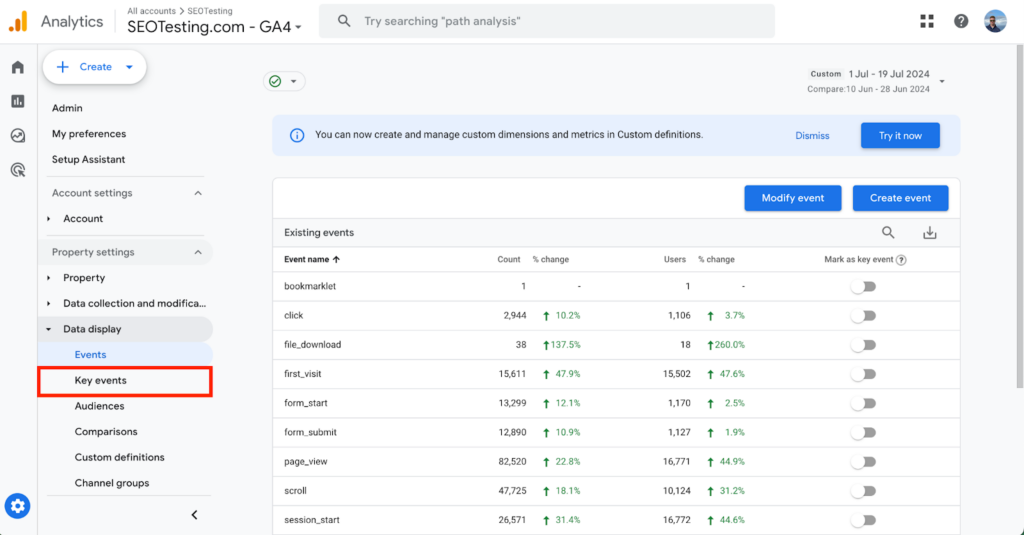
Next, click on the highlighted button to create a new key event:
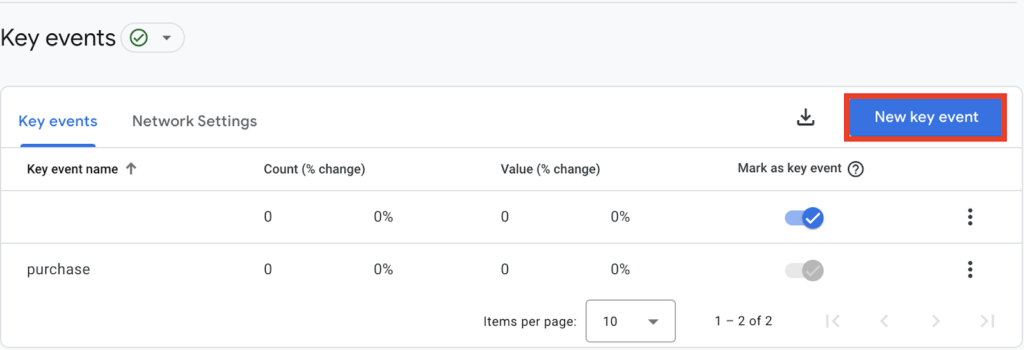
A new screen will pop up. Here, you simply need to enter the name (an exact copy) of the event you created. It’s important to note that this has a 40-character limit, so be careful when naming your events.
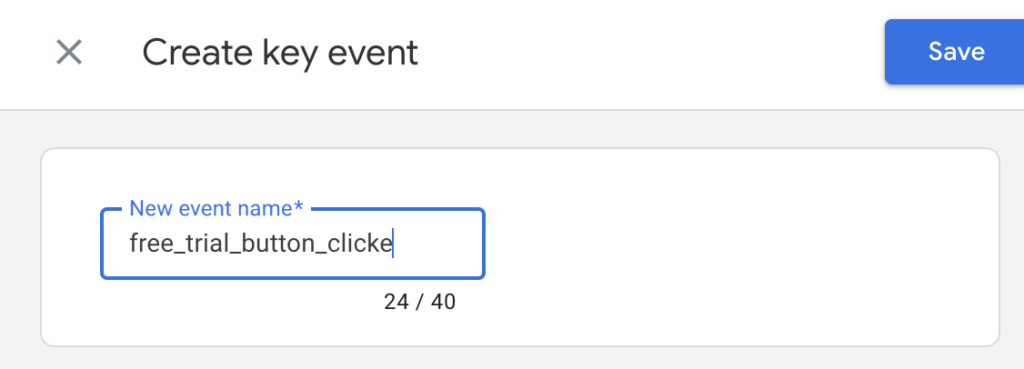
Enter your name here, and then click save. This will bring your event into a list of key events:

Monitor conversion data
To monitor your conversions, visit the ‘Events’ report within GA4. Head back to your GA4 dashboard:
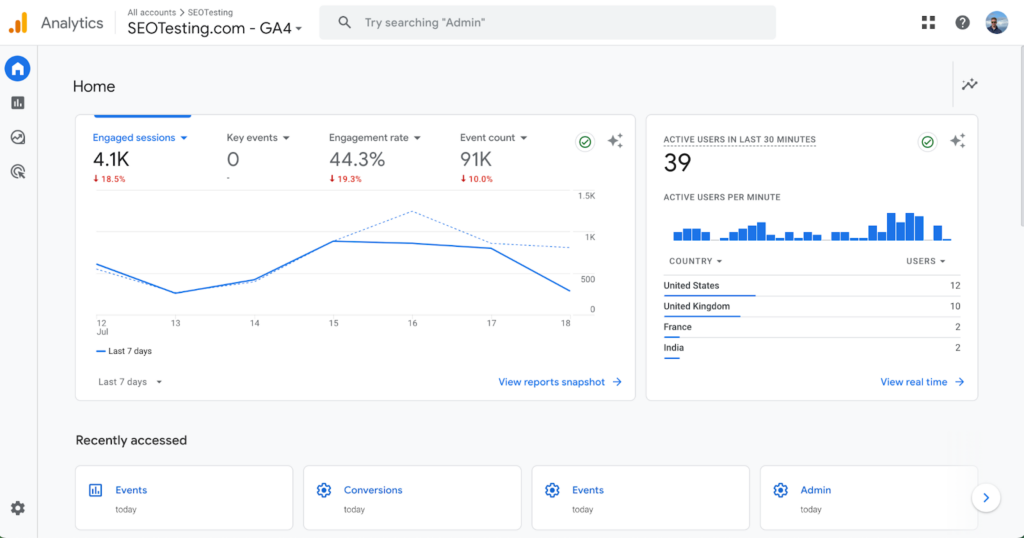
The next step is to head back to the navigation bar on the left-hand side of your screen. From there, click ‘Reports’ and then ‘Engagement’ before finally clicking on the ‘Events’ tab to get your reports.
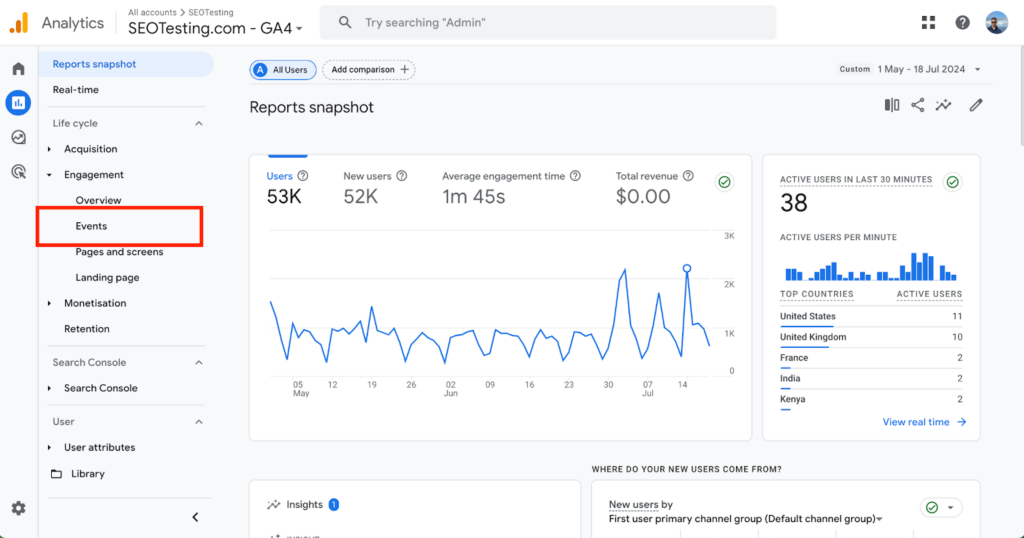
From there, you’ll be able to see a list of events that either GA4 has created or the key events that you have created listed below:
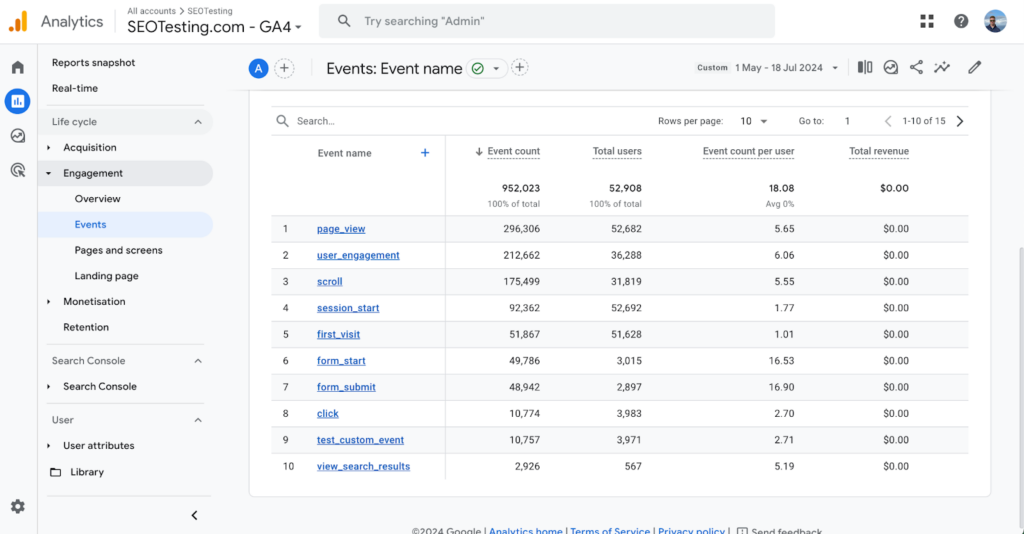
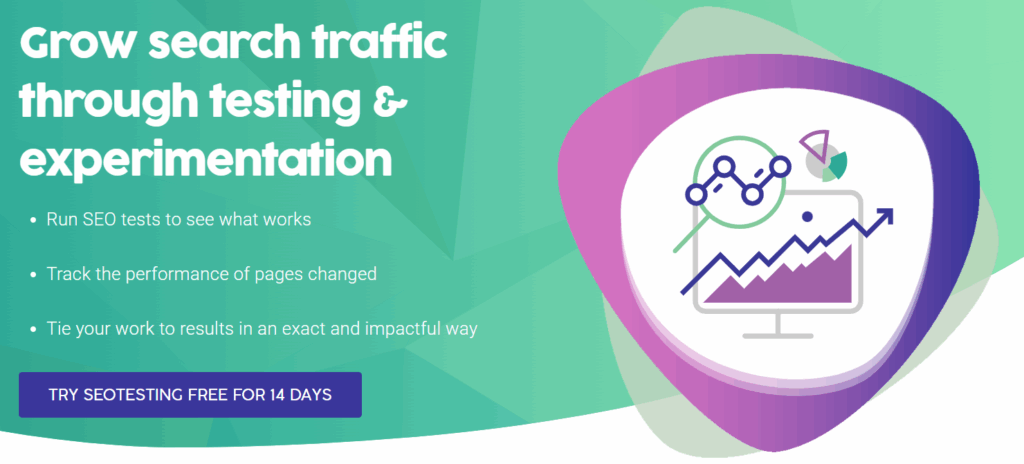
Why is conversion tracking important?
Conversion tracking is important for every business, whether you are an online retailer or a content publisher. This section will discuss some key benefits of conversion tracking for your business.
Measuring campaign effectiveness
Conversion tracking is essential for measuring the effectiveness of your marketing campaigns. It provides tangible data on how well different parts of your campaigns are performing.
You can identify which campaigns drive valuable actions like sales, sign-ups, or downloads by tracking conversions. This data helps you and your business understand which strategies are successful and which need adjustment or removal. With this insight, you can ensure resources are allocated to the top-performing strategies and campaigns.
Understanding user behavior
Understanding user behavior is another critical component of conversion tracking. By monitoring how users interact with your website, you can gain insight into their preferences, needs, and pain points. This information can then inform your marketing decisions, allowing you to tailor your content, products, and services to meet your audience’s needs and improve user satisfaction.
Improving website performance
Conversion tracking also plays a crucial role in improving your website’s performance. By knowing which elements of your site are driving conversions and which are not, you can make informed decisions about where to focus your different optimization efforts. This might involve changing and refining landing pages, adjusting call-to-action buttons, or improving site speed and usability to enhance the overall user experience.
Data-driven decision making
Tracking conversions can improve your decision-making as a marketer. By understanding your user’s behavior, you can make more accurate and effective decisions that rely on actual performance data rather than assumptions or intuition. This approach minimizes the risk of wasting resources on strategies that won’t work and maximizes the potential for achieving positive outcomes.
Conversion tracking can quantify and analyze every aspect of your marketing efforts. This allows you to identify trends, evaluate different tactics, and confidently test new ideas. As a result, you can swiftly adapt to changing market conditions, optimize your strategies in real-time, and ensure that solid data always backs your decisions.
Custom reporting & analytics
When you track your website’s conversions accurately, you can create tailored reports and dashboards focusing on your business’s most relevant metrics and KPIs. Whether you’re tracking the performance of individual campaigns, understanding the impact of different marketing channels, or monitoring progress toward business objectives, customized reports provide the insights you need.
Advanced analytics tools can also integrate conversion data to offer deeper insights and predictive analytics. These tools can uncover hidden opportunities, forecast future trends, and proactively adjust your marketing strategies. Custom reporting ensures stakeholders have access to the precise information needed to make informed decisions and drive business success.
Optimized ad spend
Optimized ad spend is a direct benefit of effective conversion tracking. By understanding which ads and campaigns drive the most conversions, you can allocate your advertising budgets more effectively. This ensures that marketing budgets are spent on strategies that give you the highest return rather than being wasted on underperforming efforts.
Improving customer experience
Another key benefit of leveraging conversion tracking is improving customer experience. By analyzing your conversion data, you can identify areas where your website’s users encounter issues, friction, and leaves your site during their journey. Addressing these pain points can lead to a smoother, more enjoyable customer experience and improved satisfaction and loyalty.
Monitor business goals
You’ll also find that monitoring your business goals becomes more streamlined and effective when you drill down and improve your conversion tracking. Tracking your conversions allows you to set specific, measurable objectives and track their progress in real-time. Whether the goal is to increase sales, grow your subscriber base, or improve customer retention, conversion tracking provides the data needed to evaluate success and make necessary adjustments.
Tracking conversions alongside SEO Testing
Tracking conversions alongside any SEO tests you run is crucial to understanding how your optimization efforts impact user experience and search engine performance.
This type of dual focus allows you to measure the conversion rates of your SEO tests and their SEO impact, providing a holistic view of your marketing strategy’s effectiveness.
When you run SEO tests, such as:
… or any other SEO test, tracking conversions helps you see beyond search engine rankings and organic traffic. You’ll understand how these SEO changes influence user behavior and conversion rates. For example, a higher-ranking page might not necessarily translate to more conversions if the content doesn’t meet the user’s expectations for that page. By tracking conversions, you can identify which SEO optimizations lead to meaningful user actions and refine your strategy to focus on what drives real business results.
Equally, when implementing Conversion Rate Optimization (CRO) tests, such as altering call-to-action placements, adjusting page layouts, or improving site speed (which we also call an SEO test), tracking their impact on SEO is equally important.
Some CRO changes might inadvertently impact your site’s SEO performance. For example, simplifying a page’s content for a better user experience might involve removing important keywords or altering the structure of the content in a way that impacts crawlability. By monitoring SEO metrics alongside conversion data, you can ensure that any changes you make for more conversions do not tank your website’s performance on the SERPs.
Here is a test we recently completed:
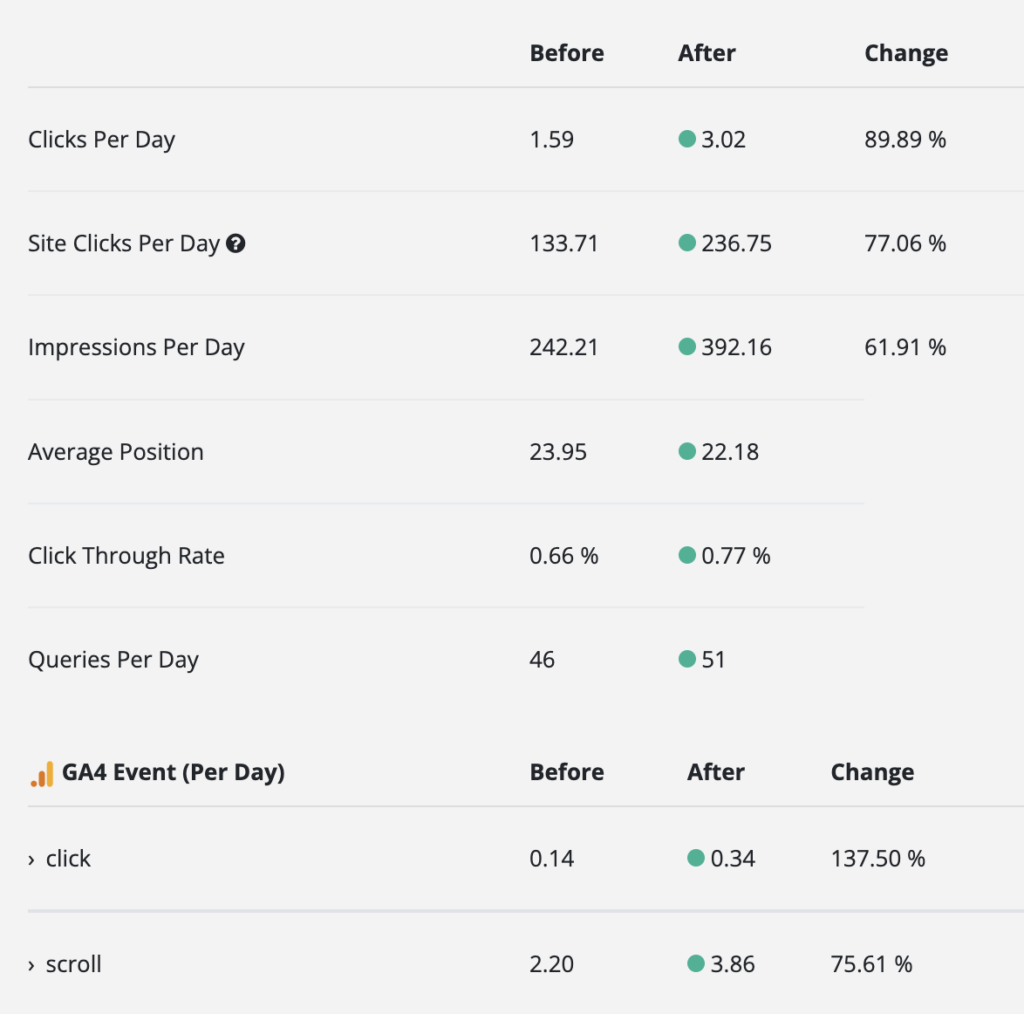
As you can see, we improved from a traffic standpoint (increasing clicks to that page per day by nearly 90%) and users’ experience on the site. We increased the number of times users clicked around the page and the number of times they scrolled. This is an example of a successful SEO (and CRO) test.
Wrapping things up
Setting up conversion tracking in GA4 is essential for any marketer looking to measure and optimize their campaign effectiveness, understand user behavior, and enhance website performance. Following the detailed steps outlined in this guide, you can seamlessly integrate conversion tracking into your GA4 property and capture valuable data on user actions.
The importance of conversion tracking cannot be overlooked. It improves data-driven decision-making, allowing you to allocate resources more efficiently and focus on strategies that yield the highest returns. It also provides critical insights into user interactions, helping refine and improve customer experience.
Monitoring conversions alongside your SEO testing is particularly crucial. This dual approach ensures optimization efforts positively impact user engagement rates and search engine performance. By tracking conversions, you can identify the real impact of your SEO changes and drive meaningful business results.
Effective conversion tracking empowers marketers to create tailored reports, optimize ad spend, and precisely monitor business goals. Leveraging these insights will enhance your marketing strategies and contribute significantly to achieving your overall business objectives.
Looking for an SEO testing tool that will meet your needs? Give SEOTesting a try. We have a 14-day free trial that doesn’t require a credit card to sign up for, so give us a try today and start testing how your website changes impact CRO.


